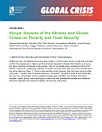Kenya: Systematic analysis of domestic production and world market shocks
Mukashov, Askar · Mbuthia, Juneweenex · Omune, Lensa · Jones, Eleanor · Thurlow, James
Apr 2025 · Economywide Risk Assessment Country Brief Book 2 · Intl Food Policy Res Inst
Ebook
14
Pages
family_home
Eligible
info
reportRatings and reviews aren’t verified Learn More
About this ebook
This study explores Kenya’s vulnerability to economic shocks and identifies those contributing most to economic uncertainty. The Kenyan Computable General Equilibrium (CGE) model was employed to simulate a range of po-tential economic outcomes under various sampled shock scenarios developed using historical data to capture do-mestic agricultural yield volatilities and world market prices uncertainty for traded goods. Data mining and machine learning methods were applied to quantify the contribution of each shock to the uncertainty of economic outcomes (gross domestic product [GDP], private consumption, poverty, and undernourishment). Key findings suggest that domestic yield volatility is the key risk factor for GDP, urban consumption and poverty, while external risks, partic-ularly world beverage crop prices, are more significant for rural consumption and poverty. As the majority of those below the poverty line are rural farmers, world beverage price volatility is the top risk for national poverty levels. Finally, for undernourishment outcomes, domestic cereal yield volatility is the dominant risk factor for all household types. Understanding how possible shocks would impact various segments of the Kenyan economy and population is a critical first step in facilitating discussions on relevant risk mitigation strategies, such as increasing average crop yields, adopting technologies and practices that narrow yield uncertainties, or diversifying production away from risky crops and sectors.
Rate this ebook
Tell us what you think.
Reading information
Smartphones and tablets
Install the Google Play Books app for Android and iPad/iPhone. It syncs automatically with your account and allows you to read online or offline wherever you are.
Laptops and computers
You can listen to audiobooks purchased on Google Play using your computer's web browser.
eReaders and other devices
To read on e-ink devices like Kobo eReaders, you'll need to download a file and transfer it to your device. Follow the detailed Help Center instructions to transfer the files to supported eReaders.











